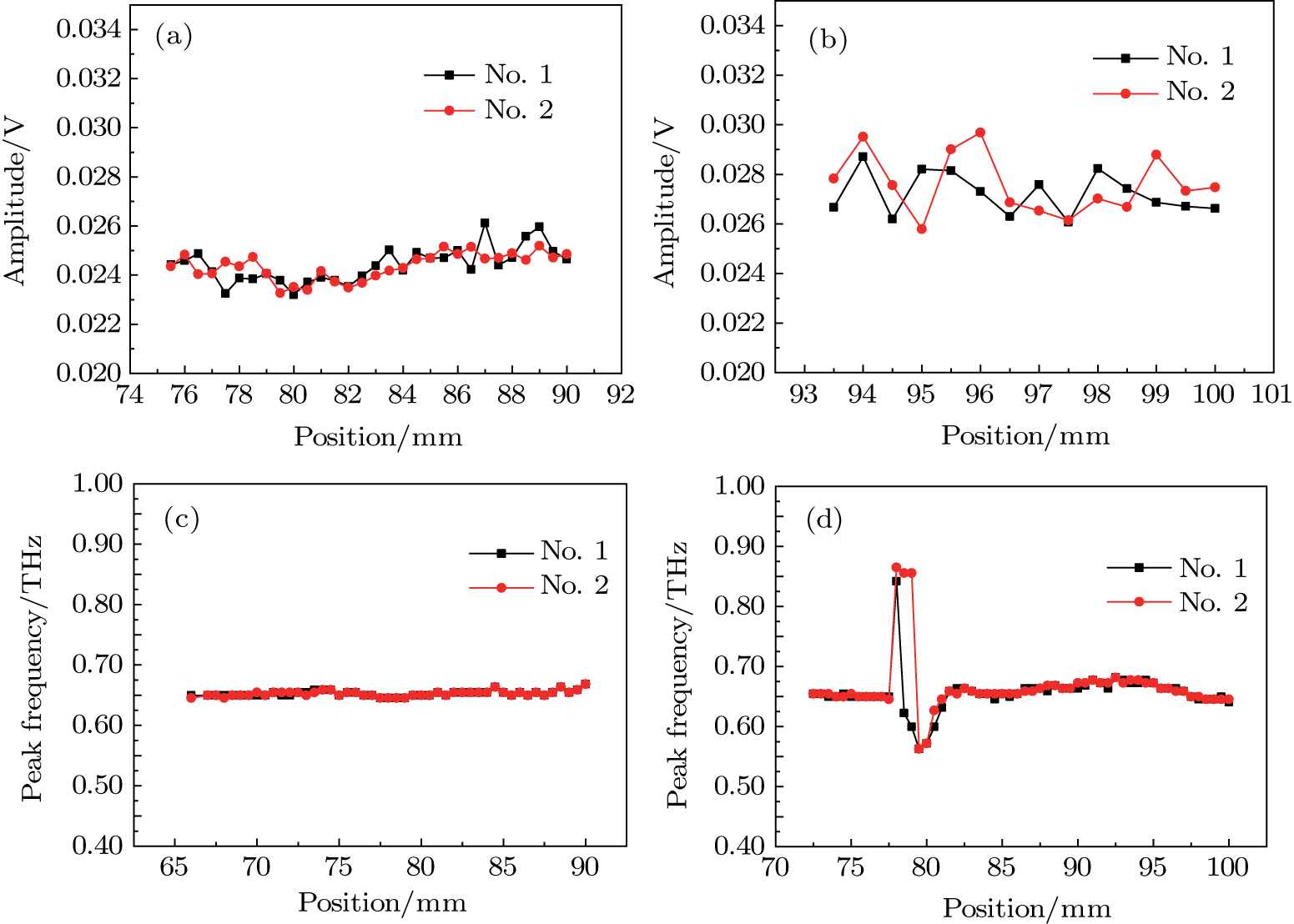† Corresponding author. E-mail:
Femtosecond laser filamentation is a method of generating terahertz, which has wide application in terahertz sub-wavelength resolution imaging. In this paper, the plasma filament formed by femtosecond laser focusing was terminated with an alumina ceramics at different positions and the influence of the cutting off position of the plasma filament on the terahertz wave was studied. The results showed that the terahertz amplitude increases as the position approaches the end of the filament gradually. The stability of amplitude and peak frequency of the terahertz generated by the filament formed by two-color femtosecond laser via a lens with a longer focal length is lower than that through a lens with a shorter focal length, especially the terahertz amplitude at the end of the filament. The study will be helpful for future researchers in the field of THz sub-wavelength imaging utilizing femtosecond laser filament.
Femtosecond laser filamentation could produce some nonlinear phenomena such as supercontinuum spectra,[1,2] conical radiation,[3,4] high order harmonic emissions,[5,6] and terahertz (THz) emissions.[7,8] Cook and Hochstrasser first introduced the THz radiation generated by femtosecond laser plasma filament in the air.[9] With application of this plasma-based THz generation technique, the THz radiations with super-broadband spectrum up to 75 THz[10] and electric field as high as 400 kV/cm[11] have been obtained. The aforesaid technique has interested many researchers in the past decade.[12–15] It has been studied in terms of the length of the plasma filament[16] formed by two-color laser, the divergence angle,[17,18] the beam diameter[19] of THz produced by femtosecond laser filament, and the relationship between the divergence angle of the terahertz radiation and the convergence conditions of the optical beam.[20]
Two-color femtosecond laser could form plasma via a focal lens, which can be used as transmission of waveguide.[21] THz wave is limited in the waveguide, thus one THz spot with sub-wavelength diameter is obtained, with which the THz sub-wavelength imaging[22] becomes possible. But the intensity of the plasma light field is up to 1014–1016 W/cm2, which could destroy many imaging objects. Thus an attenuation chip, e.g., alumina ceramics, one non-polar electrolyte material and high transmissivity in THz frequency band, is needed to be set in front of the object to protect it, yet the effect of cutting off plasma filament in different positions on producing THz remains unclear.
In this paper, the plasma filament formed by two-color femtosecond laser was cut off by alumina ceramics in different positions where the amplitude of every THz time-domain waveform was measured. Combining fast fourier transformation (FFT), the THz frequency-domain spectrum of each time-domain waveform was calculated and then the peak frequency in the spectrum was extracted. Furthermore, we calculated and compared the coefficient of variance (CV) of THz amplitude and peak frequency in different positions of plasma filament focused by two lenses with different focal lengths, 400 mm and 1000 mm respectively. The results showed that the stability of THz amplitude and peak frequency change clearly as selecting different focal lenses and cutting off plasma filament in various locations. Hence, the experiment will be useful for the study in THz sub-wavelength resolution imaging and the measuring method will probably be a new way to measure the length of the plasma filament.
The systematic diagram in Fig.
The THz waveforms are measured repeatedly in the same experimental state to test the system stability. Figure
The white line in Fig.
 | Fig. 3. (color online) (a) Plasma filament image, (b) experimental diagram of cutting off plasma filament with alumina ceramics. |
The amplitude and peak frequency of the THz waveform obtained at every position are shown in Fig.
The reason for an obvious variation of the peak frequency at z = 78 mm in Fig.
Figure
The CV shown in Table
| Table 1.
The CV of amplitude and peak frequency. . |
The results show that the shorter focal lens is more suitable to apply in THz sub-wavelength imaging based on femtosecond laser filament because of its higher filament stability. On the other hand, the cutting off position should be situated at the end of the filament, like position ii in Fig.
The alumina ceramics is moved along the laser direction to cut off the plasma filament produced by two-color femtosecond laser and the THz wave amplitude and peak frequency at each truncating position are obtained. The higher THz amplitude can be obtained when the plasma filament is terminated at the end due to the sufficient four-wave mixing rectification. And the THz amplitude tends to become saturated at the end of the filament. The stability of THz amplitude at the end of the plasma filament focused by a lens with shorter focal length is higher than that of a longer focal length lens. The experimental findings will have a wide range of applications in plasma filament formed by femtosecond laser especially in THz sub-wavelength resolution imaging.
| [1] | |
| [2] | |
| [3] | |
| [4] | |
| [5] | |
| [6] | |
| [7] | |
| [8] | |
| [9] | |
| [10] | |
| [11] | |
| [12] | |
| [13] | |
| [14] | |
| [15] | |
| [16] | |
| [17] | |
| [18] | |
| [19] | |
| [20] | |
| [21] | |
| [22] | |
| [23] |





